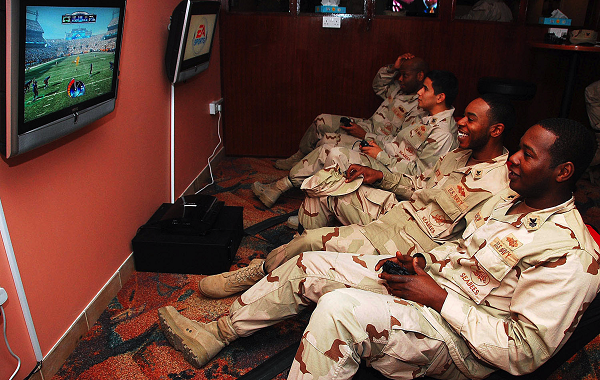Technology Isn’t That Bad

Members of the military enjoy video games. Photo via Wikimedia Commons under the Creative Commons license. http://commons.wikimedia.org/wiki/File:US_Navy_090205-N-7862M-002_Sailors_play_video_games_at_the_newly-renovated_Liberty_Center_at_Naval_Suppor t_Activity_Bahrain.jpg.
We hear all the time that technology is taking over the world in the worst ways. It comes from all ages but is prominently heard in the conversations of the older generation. But the truth is that technology is not all useless nor is it all dumbing down “the children.”
The first of many new and life changing technologies (thousands won’t even be mentioned on this list) is the DynaVox EyeMax, a system that gives individuals with cerebral palsy and paralysis and stroke victims the ability to be involved in spoken communication using their eyes. This product uses a sophisticated eye tracking system so that users can interact with an on-screen keyboard in order to translate text to speech. Not only is this a hallmark in technological advancements but it also makes the world that much more inclusive to people with such struggles.
A big issue with people who are not particularly fans of the ever-changing technologies of the twenty first century is video games. Don’t take this the wrong way: the large populations of people who play video games do it out of boredom and lack of desire for physical activity. Yet studies have shown that the simulation video games provide are a sort of therapy for people with PTSD. Thousands of veterans have found relief in games of war such as Gears of War and Call of Duty. Other reasons that video games are not the worst things in the world are: similar to sufferers of PTSD, people with consistent anxiety find comfort in hiding in their room and still achieving things. They also help occupy children’s time in summer; if you are concerned with lack of exercise among these youngsters, buy them a Wii Fit.
When the iPhone came out, it wasn’t just technophobes that were less than pleased. Blind people were able to work they’re way around a cell phone because of the buttons yet the new cool iPhone did not offer this ability and there were no reference points for blind people to find their way around sending a text or making a call. Apple realized the evident problem and created a braille display for iOS for iPad’s, iPhones (Generation 3 and older, and iPod Touches (Generation 3 and older). And even though these devices price from anywhere between $3,500 and $15,000 it provides that longed for inclusivity into the modern world that, more often than not, people with physical disabilities are generally not used to.
It’s hard to accept new ideas. First a Macintosh Computer and now a machine that will help millions around the world struggling with physical disabilities, where will it stop? The best thing to remember is that the world is constantly changing and I’m sure plenty of people from this generation will freak out when hover boards become mainstream (but that’s just because we’ve been waiting for them forever). So if you are ever struggling to understand how or why something has to be invented, try looking at it from someone else’s perspective because I promise that there is someone out there who will find comfort and acceptance with it’s creation.

I am the Senior News Editor for The Jetstream Journal. I currently have blue hair and an irrational fear of red vegetables. I'm not involved in any other...








Cris Robson • May 15, 2015 at 9:39 am
Great article Emma!